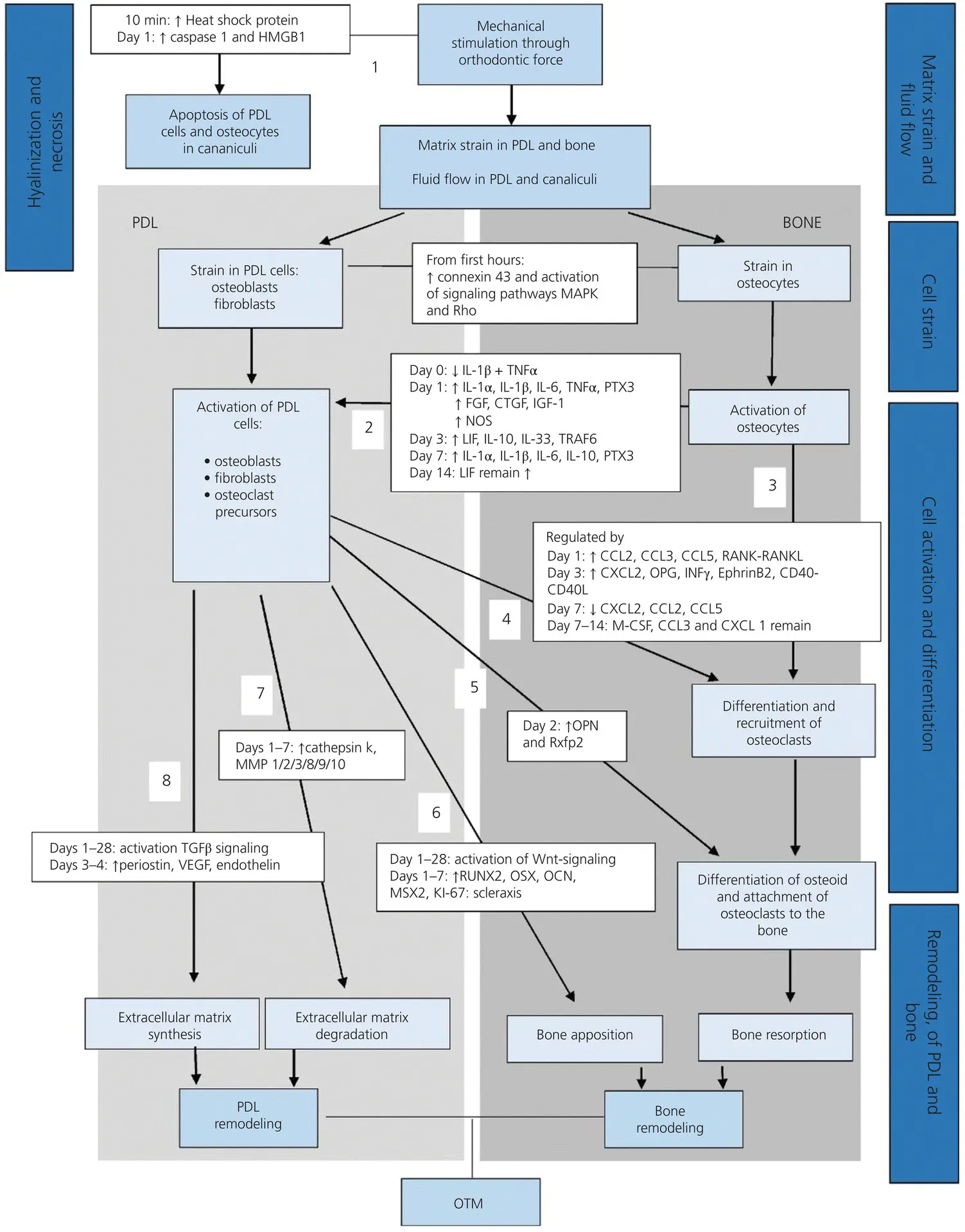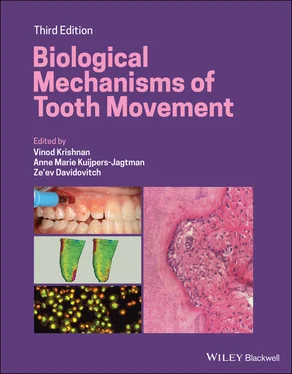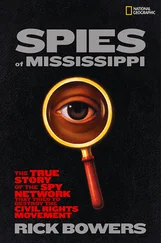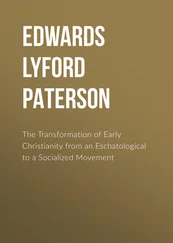At the leading side of the relapsing tooth, the sign of the strain has changed from positive to negative, and at the trailing side the opposite has happened. Consequently, the signaling and the cellular response in the PDL, the cementum, and the alveolar bone change to the opposite. This strongly indicates that the same processes as found during active tooth displacement now will take place at the opposite side of the tooth (Franzen et al ., 2013).
Indeed, histological studies have shown that during the very start of relapse, in some instances the PDL at the leading side is hyalinized. After the hyalinized tissue is removed, or directly after the start of the relapse in cases in which no hyalinization had developed, the normal structure of the PDL is completely lost through the upregulation of the MMPs by its inducer (EMMPRIN) (Xia et al ., 2019). It is replaced by loose connective tissue in which collagen type I is absent, and collagen type III fibers parallel to the root surface not connecting the tooth to the alveolar bone. Osteoclasts differentiate in this area and start alveolar bone resorption. This osteoclastogenesis and alveolar bone resorption is probably correlated with the expression of EMMPRIN and its association with RANKL and VEGF expression (Xia et al ., 2019). At the trailing side of the relapsing tooth, the PDL contains newly formed collagen type I as well as type III collagen, osteoclasts are no longer present, and osteoblasts differentiate and secrete bone tissue (Yoshida et al ., 1999).
In Chapter 19of this book, the histological changes during relapse are described in more detail and compared with the histological changes during active OTM.
Unfortunately, very little research has been performed on the cell and molecular biology aspects of relapse. Franzen and co‐workers (2013) found that during active tooth movement gene expression of OCN, Coll‐I, and ALP decreased at the leading side, and that they tended to increase again while the molars relapsed. The reverse was seen for the genes of RANKL and TRAP. Their expression increased at the leading side during active tooth movement and returned to control levels during relapse
Although the literature on this topic is sparse, the available data suggest that changes in the mechanical circumstances in the PDL, due to the abolition of the external orthodontic forces, result in similar biological reactions as when an orthodontic appliance is activated. This means that teeth do not have “a tendency to move back towards the original malocclusion”, as stated in many textbooks, but that they react to changes in local mechanical conditions.
Orthodontic movement of teeth to a new position in the dental arch is the result of a highly complex biological process in response to the applied force. The PDL and the alveolar bone with their different cell types and ECM play a dominant role in activating the tissue response to enable movement. Many molecules have been implicated in this response, but a well‐integrated model representing a unified scheme is still incomplete.
The most recent model is given in the systematic review by Vansant et al . (2018) on the expression of biological mediators during OTM which is based on the model by Henneman et al . (2008) ( Figure 3.16). Future research will fill in the gaps of knowledge that still exist. Every patient differs biologically and with increasing knowledge of the biological processes involved in OTM we may be able to design a personalized approach for each individual patient based on his or her biological profile. This will hopefully make the process of OTM more efficient than the standard approach we offer our patients today.

Figure 3.16 Theoretical model of orthodontic tooth movement (OTM) based on the model by Henneman et al. (2008).
(Source: Vansant et al ., 2018. Reproduced with permission of Elsevier.)
1 Barczyk, M., Bolstad, A. I. and Gullberg, D. (2013) Role of integrins in the periodontal ligament: organizers and facilitators. Periodontology 2000 63(1), 29–47. doi:10.1111/prd.12027.
2 Bergomi, M., Cugnoni, J., Botsis, J. et al. (2010) The role of the fluid phase in the viscous response of bovine periodontal ligament. Journal of Biomechanics 43(6), 1146–1152. doi:10.1016/j.jbiomech.2009.12.020.
3 Binderman, I., Zor, U., Kaye, A. M. et al. (1988) The transduction of mechanical force into biochemical events in bone cells may involve activation of phospholipase A2. Calcified Tissue International 42(4), 261–266. doi:10.1007/bf02553753.
4 Burger, E. H. and Klein‐Nulend, J. (1999) Mechanotransduction in bone – role of the lacuno‐canalicular network. The FASEB Journal 13(Suppl.), S101–112.
5 Burridge, K. and Chrzanowska‐Wodnicka, M. (1996) Focal adhesions, contractility and signaling. Annual Review of Cell and Developmental Biology 12, 463–518. doi:10.1146/annurev.cellbio.12.1.463.
6 Burstone, C. J. (1962) The biomechanics of tooth movement, in Vistas in Orthodontics (eds B. S. Kraus and R. A. Riedel). Lee & Febiger, Philadelphia, PA, pp. 197–213.
7 Chen, X., Li, N., LeleYang, Liu, J. et al. (2014) Expression of collagen I, collagen III and MMP‐1 on the tension side of distracted tooth using periodontal ligament distraction osteogenesis in beagle dogs. Archives of Oral Biology 59(11), 1217–1225. doi:10.1016/j.archoralbio.2014.07.011.
8 Chiquet, M., Renedo, A. S., Huber, F. and Flück, M. (2003) How do fibroblasts translate mechanical signals into changes in extracellular matrix production? Matrix Biology 22(1), 73–80. doi:10.1016/s0945‐053x(03)00004‐0.
9 Chiquet, M., Tunç‐Civelek, V. and Sarasa‐Renedo, A. (2007) Gene regulation by mechanotransduction in fibroblasts. Applied Physiology, Nutrition and Metabolism 32(5), 967–973. doi:10.1139/h07‐053.
10 Cobo, T., Viloria, C. G., Solares, L. et al. (2016) Role of periostin in adhesion and migration of bone remodeling cells. PLoS One 11(1), e0147837. doi:10.1371/journal.pone.0147837.
11 Davidovitch, Z. (1991) Tooth movement. Critical Reviews in Oral Biology and Medicine 2, 411–450.
12 Dean R. (2017) The periodontal ligament: development, anatomy and function. Oral Health and Dental Management 16(6), 1–7.
13 Duong, L. T., Lakkakorpi, P., Nakamura, I. and Rodan, G. A. (2000) Integrins and signaling in osteoclast function. Matrix Biology 19(2), 97–105. doi:10.1016/s0945‐053x(00)00051‐2.
14 Eriksen, E. F. (2010) Cellular mechanisms of bone remodeling. Reviews in Endocrine and Metabolic Disorders 11(4), 219–227. doi:10.1007/s11154‐010‐9153‐1.
15 Feller, L., Khammissa, R. A., Schechter, I. et al. (2015) periodontal biological events associated with orthodontic tooth movement: the biomechanics of the cytoskeleton and the extracellular matrix. Scientific World Journal 894123. doi:10.1155/2015/894123.
16 Fernández‐Tresguerres‐Hernández‐Gil, I., Alobera‐Gracia, M. A., del‐Canto‐Pingarrón, M. and Blanco‐Jerez, L. (2006a) Physiological bases of bone regeneration I. Histology and physiology of bone tissue. Medicina Oral Patologia Oral y Cirugia Bucal 11(1), E47–51.
17 Fernández‐Tresguerres‐Hernández‐Gil, I., Alobera‐Gracia, M. A., del‐Canto‐Pingarrón, M. and Blanco‐Jerez, L. (2006b) Physiological bases of bone regeneration II. The remodeling process. Medicina Oral Patologia Oral y Cirugia Bucal 11(2), E151–157.
18 Franzen, T. J., Brudvik, P. and Vandevska‐Radunovic, V. (2013) Periodontal tissue reaction during orthodontic relapse in rat molars. European Journal of Orthodontics 35(2), 152–159. doi:10.1093/ejo/cjr127.
Читать дальше













